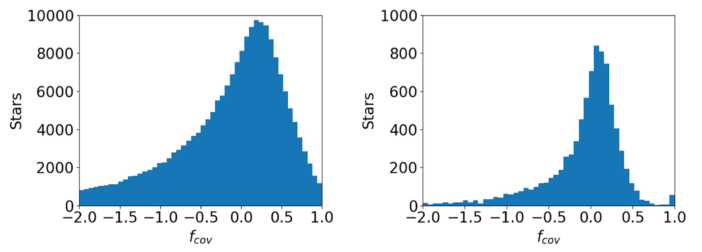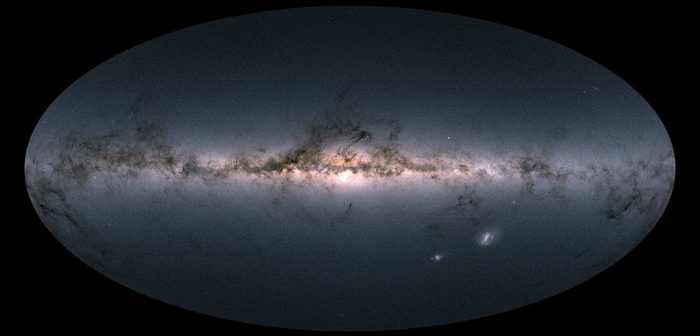Signs of extraterrestrial intelligence don’t appear in the astrophysical literature very often. One of the most well-known signposts of advanced spacefaring civilizations, a Dyson sphere (see Figure 1), named after physicist Freeman Dyson, is a theorized structure surrounding a star, through which a highly technologically advanced civilization could harness the full energy output of its star.Editor’s note: This article, written by AAS Media Fellow Kerry Hensley, was originally published on Astrobites.
Most Dyson sphere searches to date have looked for excess infrared radiation. Since a large portion of the star is covered, the amount of visible light emitted drops sharply. However, the emission from the Dyson sphere itself, which has an estimated temperature between 50 and 1,000 K, peaks in the infrared. So far, searches for infrared excesses have come up empty.
Science with a Side of Sci-fi
In today’s paper, Zackrisson and coauthors looked for Dyson spheres with little or no infrared excess, just the sort that would have been overlooked by past searches. Specifically, they considered the case of a Dyson sphere made of a gray absorber — a material that dims the star’s light equally at all wavelengths. An observer will see the same overall shape of the star’s spectrum, but the flux will be lower everywhere.
This means that if you try to measure the distance to the star spectrophotometrically — by comparing the star’s observed flux and spectrum to stellar emission models — your measurements will tell you that the star is farther away than it actually is. However, the dimming of the star by the Dyson sphere won’t fool the parallax method, which uses the apparent movement of the target star against the background of more distant stars seen as Earth orbits the Sun. The greater the difference in distances from these two methods, the larger the fraction of the star’s surface is covered by the Dyson sphere.
Zackrisson and collaborators compared parallax distances from the first data release of Gaia, the European Space Agency’s spacecraft tasked with charting the positions and motions of a billion stars, to the spectrophotometric distances from the Radial Velocity Experiment (RAVE), which takes spectra of stars in the Milky Way. By comparing the stars’ spectrophotometric distances from RAVE to their parallax distances from Gaia, the authors estimated the fraction of each star covered by Dyson sphere material. As Figure 2 shows, this resulted in a wide range of covering fractions for the stars in their sample.

Figure 2. Distribution of covering fractions for all stars in the Gaia-RAVE database overlap (left) and just those stars with less than 10% error in their Gaia parallax distance and less than 20% error in their RAVE spectrophotometric distance (right). If, due to large errors or other reasons, the parallax distance is smaller than the spectrophotometric distance, the analysis interprets this as a negative covering fraction. [Zackrisson et al. 2018]
Will the Real Dyson Sphere Please Stand Up?
To narrow down their list of candidates, the authors limited their search to main-sequence stars of spectral types F, G, and K, with a covering fraction greater than 0.7; the spectrophotometric distances for giant stars tend to be overestimated compared to main-sequence stars, so they got the boot. This left just six stars. A further four stars fell due to issues with the data, leaving only two Dyson sphere candidates. Of these two stars, the authors selected TYC 6111-1162-1, an F dwarf with a temperature of 6,200 K, as the most promising candidate.
TYC 6111-1162-1 seemed to be a garden-variety late-F dwarf, and follow-up high-resolution spectroscopy overwhelmingly confirmed the star’s known parameters. With no apparent fishiness in the star’s parameters, the distance discrepancy between RAVE and Gaia still stood. Have we found the first sign of extraterrestrial intelligence?! Given the lack of news stories, you probably already know the answer! TYC 6111-1162-1’s distance discrepancy may be due to the fact that it’s not one star but two — a binary system with a hidden white-dwarf companion — which the authors of today’s paper discovered using radial velocity measurements. It’s still not totally clear what’s going on with this star, but future Gaia data releases may hold the answer — and if we’re lucky, subtle signs of a distant civilization…
Citation
“SETI with Gaia: The Observational Signatures of Nearly Complete Dyson Spheres,” Erik Zackrisson et al 2018 ApJ 862 21. doi:10.3847/1538-4357/aac386

